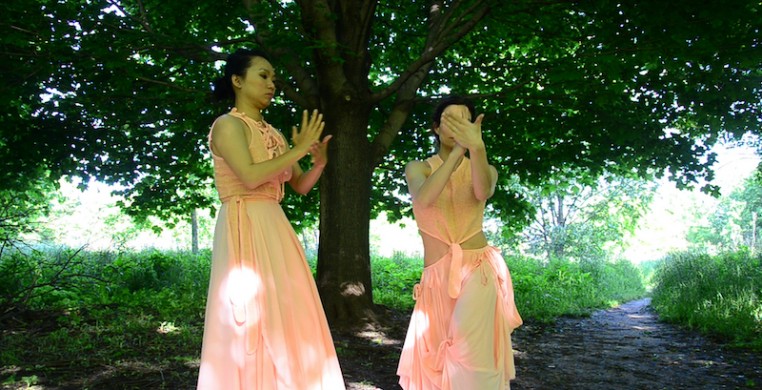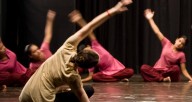In keeping the spirit of Chicago Dance Month alive during quarantine and as See Chicago Dance focuses on dancer health this May, I talked with dance/movement therapists and artists versed in kinesthetic practices to break down dance/movement therapy for those who need it, to provide resources for those struggling to meet basic needs and to outline basic coping strategies to get artists and arts administrators across the city through the day-to-day of living in quarantine.
Why Dance/Movement Therapy?
Dance/movement therapy (DMT) uses movement along with other psychotherapeutic methods to approach well-being and mental health through an embodied practice. Dance/movement therapists are licensed counselors trained to do verbal counseling as well as to approach anxiety, depression, overwhelming feelings, trauma and more through body-based exercises. In DMT, movement acts as a way to express oneself during the session, potentially leading to a verbal dialogue, and vice versa. Certain exercises can also help regulate emotions and personal experiences on a daily basis. DMT is open to all people and all levels of dance exposure, and can be a great resource for those who have trouble expressing themselves verbally or who have limited mobility and want to strengthen their mind-body connection.
“Dance/movement therapists believe everybody, no matter what their challenges are, can dance and can mobilize, even if it’s using their active imagination. [DMT is] all about attending to our bodies,” said Lisa Goldman, a Chicago dance/movement therapist of 26 years who specializes in counseling survivors of brain injuries. Goldman also has her Graduate Laban Certificate in Movement Analysis (Laban Movement Analysis provides a neutral way to analyze, discuss and approach movement) and teaches the Laban method to others looking to be certified.
It’s typical that, despite the obvious connection between DMT and an artistic dance practice, dance/movement therapists typically don’t see active or professional dancers as clients. Erica Hornthal, a Chicago dance/movement therapist who participated in the 2019 See Chicago Dance Day of Dancer Health, noted that most of her clients hadn’t danced before starting DMT, or had stopped dancing when they were young. Hornthal attributes this partially to a lack of conversations surrounding mental health in dancer training, as well as a lack of knowledge about the benefits of the mind-body connection that DMT offers.
“For dancers, especially those who perform for a living, dance brings up more anxiety for a lot of people,” Hornthal said. “But there’s so much more movement outside of physical activity and dance that we need to engage in that helps regulate our nervous systems: breathing, expanding, contracting, walking, gesturing, posturing. We need to be giving our body the recuperation that it needs, and we need to find other ways to move for our health and well-being, outside of exercise.”
Ashley Fargnoli, a dance/movement therapist and choreographer based in Chicago who primarily worked with refugee and immigrant clients, remembered only having one client who was a dancer. Fargnoli, who is currently working in Sri Lanka as a Fulbrite Scholar, didn’t know DMT existed until a few years after she completed undergraduate education studying political science. It was after spending three years in post-war Bosnia, where she realized the body’s direct connection to trauma, that she decided to become a dance/movement therapist.
“That’s what really compelled me to go into dance/movement therapy—understanding that trauma lives in the body and even if we’re doing just a dance class, that can evoke a trauma response in people,” said Fargnoli. “After witnessing that in Bosnia—there is just so much trauma 25 years after the war has ended, and people are still coping with a lot of trauma—that compelled me into dance/movement therapy and work with refugees and anyone who has undergone trauma.”
Tackling Trauma at Home
For any artist struggling with a loss of safety or basic security due to COVID-19, Fargnoli shared multiple ways to help meet your primary needs and gain a sense of stability. She recommended other psychosocial help outside of therapy, such as finding a case manager or social worker who can help with logistical things such as filing for unemployment (see our list of resources below).
To deal with immediate stress in the body or to help focus energy on tackling primary needs, Fargnoli recommended finding strength and control instead of relaxation in the body, as it can often feel unsafe to relax.
Finding personal strength, whether identifying a literal muscle that feels strong or a figurative strengthening feeling about a certain area of the body can be a helpful practice.
A palm tree exercise, as one of Fargnoli’s clients named it, connects the upper and lower body while also grounding the body to help you “literally weather through the storm.” Imagine your lower body (legs and pelvis) as the trunk of a palm tree rooted in the sand. Then allow your upper body (stomach, chest, head and arms) to have flexibility and mobility like the palm leaves of the tree.
“Even if everything seems so uncertain and out of control in terms of what we can control, we can find a sense of control in our own bodies and find a sense of stability,” said Fargnoli.
Day-to-Day Strategies
There are other simple activities you can do at home in minutes to help alleviate stress, anxiety and depression from the pandemic.
One of the simplest practices is to take a couple minutes each day to breathe—not necessarily deep breaths, as that can deepen anxiety for certain people—to remind the body and mind of its “foundational connection,” as Goldman described it. Notice your breath, its pace and where it rests in the body—higher in your chest or low in your belly, for example.
“You don’t have to increase it or change it, but it’s really important that we notice our breath several times throughout the day, to just notice if we’re holding it—is it stiff, tight, shallow?” Hornthal said.
For those interested in adding a bit of dance to their breath check-ins, Goldman suggests allowing your body to move—big or small—either contrasting the rhythm of your breath or matching it.
Another basic practice is the body scan, where from head to feet or feet to head, you take time to notice and give attention to the different parts of your body. Are your calves feeling tense? Your chest tight? You don’t have to make changes to your body—understanding how you’re feeling or connecting to your body each day can be enough to help you feel more at ease—but you can take the time to move certain areas of your body to alleviate some of that stress, whether that’s rolling your shoulders or wiggling your knee or giving yourself a massage. Doing the body scan to music can have added benefits. Fargnoli also recommended doing this body scan against a wall or the floor to give yourself a feeling of support.
Because spending so much time indoors shifts the musculature to narrow and stiffen, Goldman shared a Laban “Shape Flow” exercise that focuses on the natural expanding or shrinking of the body, as well as connecting your internal headspace or emotions with the external world: Reach away from the body then come back to yourself, making the choice of how far away from your core you want to reach different limbs and body parts. Similar to the body scan, this can be done by isolating body parts head to toe and vice versa, then engaging your entire body at once.
Andrea Cerniglia, artistic director of Dropshift Dance and GLCMA, does activities like these on a regular basis regardless of the state of the world, but since quarantine began she has tried to integrate the practices more often into her daily routine.
“What has been really successful for me has been leaning into physical activities that allow me to practice self care, practice mindfulness exercises—and that has been distilling things down to basic functions of the body,” said Cerniglia. “Just very clean, simple, streamlined tasks.”
Supporting your artistic practice during a pandemic
When it comes to feeling anxious, overwhelmed or stressed at home, many dancers find those feelings elevated through the inability to maintain or adapt their artistic practices. Whether it’s feeling guilty because you aren’t dancing, a lack of motivation to dance right now, or frustration from malfunctioning technology or a lack of space in your living room, the therapists I interviewed universally advised compassion, kindness and generosity towards yourself.
“We are all functioning at 20 percent capacity, so it’s normalizing that. Give yourself permission to rest,” Fargnoli said. “It’s hard because artists, especially freelancers, are used to constantly looking for things and looking for money and how to support yourself. And I know that can’t completely stop for some people, but even just taking a moment to rest can be OK, at least just to get us to a place to focus on what we can do and what we can control.”
At the same time, Goldman stresses the importance of “absolutely staying creative” and making things—whether that be dance related, or through cooking, music, crafting, etc.
“When we’re making something, we’re being creative, and when we’re accessing our creativity, we’re accessing our healthiest parts,” Goldman said. “As artists, if you’re not doing your art, whatever modality that is, that typically leads to depression or anxiety. If we came into the world meant to express or create a certain way, and then we’re not doing that: ouch. The more whole we feel, the more at peace we feel in the world, even during a quarantine and pandemic.”
For artists struggling to embrace an artistic practice or even basic exercise and health practices during this time, Goldman recommends noticing the tiny stretches or dances that a person does instinctively on a daily basis and leaning into those moments, possibly building on them to add a few minutes of movement to the middle of each day. It can also be helpful to ask, “How do I create shift?” to help balance what our bodies want with gentle shifts towards any goals of artistic, mindful or exercise practices.
“If we’re noticing ourselves being caught by something that we know is not necessarily for our greater good, how can we with compassion and gentleness create a shift for ourselves out of that, without shaming?” Goldman said.
Cerniglia shared that as an active artist and as a director, she has prioritized letting go of creating a product, instead focusing on being there for her dancers. They check in weekly over Zoom, sometimes related to their artistic research that week, but often simply to decompress and talk about their weeks. As a human being, her top priority has been being present at home with her husband and kids. She shared that it can be helpful to think about engaging in virtual social connection as completing a valid, productive task.
For an activity that engages creativity in a simple way, Cerniglia advises going on a meditative walk. Walk for 30 minutes outside, improvise movement based on what you saw or experienced, then go home. Cerniglia also likes to take Emily Stein’s virtual Feldenkrais Awareness Through Movement, a pay-what-you-can class that Cerniglia described as a “very gentle, meditative practice that is exhaustive in a brain-body way.” Anyone interested in taking the class can contact Stein through her website.
And for teachers struggling with moving their classes online, the Dance Studies Association has a catalogue of resources including two webinars on online dance teaching and links to general online teaching resources—even an article about tackling imposter syndrome when teaching online.
Through it all, Hornthal, Goldman, Fargnoli and Cerniglia stressed the importance of being compassionate with yourself and returning to the basic concepts of breath, mobilization, self expression, strength and creation.
“If you can just hone in on movement in general, and make sure that we’re moving every day, and we can ease our anxiety, then we might find out that there’s more room for you to dance.” Hornthal said.
--
As a part of See Chicago Dance’s focus on dancer health this May, Erica Hornthal will lead an online workshop “Taking Care of Your Mental Health During a Pandemic” on Tuesday, May 5 at 11:30a CST. You can register for this free event by clicking the event link here.
DMT and other arts therapy resources:
American Dance Therapy Association (for more on DMT and a system to locate a DMT near you)
In Touch and Motion (may offer sliding scale)
Erica Hornthal’s 2019 SCD article on addressing mental health in dance
Resources courtesy of Ashley Fargnoli:
Comprehensive List of Mental Health Services, Financial Assistance, Housing Assistance and Legal Assistance Related to Covid-19
Intimate Partner Violence Hotlines: 24 Hour Help Line: 800-603-4357 (Between Friends)
Chicago Clinics that offer sliding scale: (there are dance/movement therapists that work at some Live Oak and Howard Brown locations)
Crisis Lines: If you are having thoughts of harming yourself or others, immediate support can be achieved by calling The National Suicide Hotline (1-800-273-8255), texting HOME to 741741, or by calling the TransLifeline (877-565-8860).



